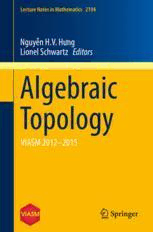
Algebraic Topology: VIASM 2012–2015 PDF
Preview Algebraic Topology: VIASM 2012–2015
Lecture Notes in Mathematics 2194 Nguyễn H.V. Hưng Lionel Schwartz E ditors Algebraic Topology VIASM 2012–2015 Lecture Notes in Mathematics 2194 Editors-in-Chief: Jean-MichelMorel,Cachan BernardTeissier,Paris AdvisoryBoard: MichelBrion,Grenoble CamilloDeLellis,Zurich AlessioFigalli,Zurich DavarKhoshnevisan,SaltLakeCity IoannisKontoyiannis,Athens GáborLugosi,Barcelona MarkPodolskij,Aarhus SylviaSerfaty,NewYork AnnaWienhard,Heidelberg Moreinformationaboutthisseriesathttp://www.springer.com/series/304 Nguyễn H.V. Hưng • Lionel Schwartz Editors Algebraic Topology VIASM 2012–2015 123 Editors NguyễnH.V.Hưng LionelSchwartz DepartmentofMathematics LAGA,UMR7539CNRSInstitutGalilée VietnamNationalUniversity UniversitéParis13 Hanoi,Vietnam Villetaneuse,France ISSN0075-8434 ISSN1617-9692 (electronic) LectureNotesinMathematics ISBN978-3-319-69433-7 ISBN978-3-319-69434-4 (eBook) https://doi.org/10.1007/978-3-319-69434-4 LibraryofCongressControlNumber:2017957829 MathematicsSubjectClassification(2010):55P50,55Q45,55S10,18E10,18GXX ©SpringerInternationalPublishingAG2017 Thisworkissubjecttocopyright.AllrightsarereservedbythePublisher,whetherthewholeorpartofthe materialisconcerned,specificallytherightsoftranslation,reprinting,reuseofillustrations,recitation, broadcasting,reproductiononmicrofilmsorinanyotherphysicalway,andtransmissionorinformation storageandretrieval,electronicadaptation,computersoftware,orbysimilarordissimilarmethodology nowknownorhereafterdeveloped. Theuseofgeneraldescriptivenames,registerednames,trademarks,servicemarks,etc.inthispublication doesnotimply,evenintheabsenceofaspecificstatement,thatsuchnamesareexemptfromtherelevant protectivelawsandregulationsandthereforefreeforgeneraluse. Thepublisher,theauthorsandtheeditorsaresafetoassumethattheadviceandinformationinthisbook arebelievedtobetrueandaccurateatthedateofpublication.Neitherthepublishernortheauthorsor theeditorsgiveawarranty,expressorimplied,withrespecttothematerialcontainedhereinorforany errorsoromissionsthatmayhavebeenmade.Thepublisherremainsneutralwithregardtojurisdictional claimsinpublishedmapsandinstitutionalaffiliations. Printedonacid-freepaper ThisSpringerimprintispublishedbySpringerNature TheregisteredcompanyisSpringerInternationalPublishingAG Theregisteredcompanyaddressis:Gewerbestrasse11,6330Cham,Switzerland Introduction The algebraic topology activities at the Vietnam Institute for Advanced Study in Mathematics (VIASM) have been organized every other year, in 2013, 2015, and 2017, since the institute’s establishment. These sessions reflect the healthy cooperationbetweentheVietnameseandoverseasschoolsinhomotopytheory. Thethreearticlescomprisingthisvolumeareexpandedversionsofcoursesgiven duringthealgebraictopologyatVIASMbyH.-W.Henn,G.Powell,andG.Ginot. In addition to the courses covered by this book, lectures on and activities about algebraic topology at VIASM have also been conductedby M. Hill (on the Kervaireinvariantproblem),A.TouzéandV.Franjou(onfunctorhomology),and B.Fresse(onoperads)andtwocourseshavebeenpresentedbyJ.Lannesongroup cohomology. During these activities and during Lannes’ visits, various seminars weregiven. Althoughthese notescontainsomenewresultsandnewpresentations(particu- larly in Ginot’s article), their primarypurpose is to provideeasier access to some recent topics, both to the Vietnamese algebraic topology community and more widelytoallalgebraictopologists. The topics covered may be divided into two groups:stable homotopy,unstable moduletheory,andchromatichomotopytheory(HennandPowell)ontheonehand; andstringandbranetopology(Ginot)ontheotherhand. Henn’s article provides an introduction to localization with respect to Morava K-theoriesandhowthecohomologyoftheMoravastabilizergroupcangiveaccess (viaaspectralsequence)tothehomotopyofthelocalization.Thisisaverywelcome and clearly written self-contained survey which introduces readers to the more technicalliterature. Powell’s article is concerned with derived functors of the destabilization and iterated loop functorsfor unstablemodulesand gives a small complex that allows theircomputation.Details arealso givenconcerningthe oddprimecase. Thisis a subjectwhichiswellknowntotheVietnameseschoolinhomotopytheory. Ginot’sarticleisawidelyexpandedversionofhisintroductorycourseon“string andbranetopology”andhigherHochschildhomology,providingsomenewresults. It presents a much-needed summary of the main results and constructions in the v vi Introduction field,fillingagapintheexpositoryliterature.Thiseasy-to-readarticlewillbeuseful tobothstudentsandexpertsinthefield. Theeditorswishtowarmlythankthescientificdirector,themanagingdirector, and the staff of VIASM for their hospitality and efficiency and for the pleasant working conditions of the institute. This applies both to the abovementioned algebraictopologyactivitiesandtomorerecentones,inparticularthesessionheld inTalinpa(TuanChau)in2016,whichprovidedexceptionalworkingconditionsfor asmallgroupofresearchersandstudents. Hanoi,Vietnam NguyễnH.V.Hưng Villetaneuse,France LionelSchwartz Contents 1 Hodge Filtration and Operations in Higher Hochschild (Co)homologyandApplicationstoHigherStringTopology............ 1 GrégoryGinot 2 OntheDerivedFunctorsofDestabilizationandofIterated LoopFunctors................................................................ 105 GeoffreyPowell 3 AMini-CourseonMoravaStabilizerGroups andTheirCohomology...................................................... 149 Hans-WernerHenn vii Chapter 1 Hodge Filtration and Operations in Higher Hochschild (Co)homology and Applications to Higher String Topology GrégoryGinot Abstract This paper is based on lectures given at the Vietnamese Institute for Advanced Studies in Mathematics and aims to present the theory of higher Hochschild(co)homologyanditsapplicationtohigherstringtopology.Thereisan emphasison explicitcombinatorialmodelsprovidedby simplicialsets to describe derivedstructurescarried or describedby Higher Hochschild(co)homologyfunc- tors. It contains detailed proofs of results stated in a previous note as well as somenewresults.Oneofthemainresultisa proofthatstringtopologyforhigher spheres inherits a Hodge filtration compatible with an (homotopy) E -algebra nC1 structureonthechainsford-connectedPoincarédualityspaces.Wealsoprovethat theE -centralizerofmapsofcommutative(dg-)algebrasareequippedwithaHodge n decomposition and a compatible structure of framed E -algebras. We also study n Hodge decompositions for suspensions and products by spheres, both as derived functorsandcombinatorially. 1.1 IntroductionandOverview This paper is based on lectures given at the Vietnamese Institute for Advanced Studies in Mathematics. It aims to present both the theory of higher Hochschild (co)homology and its application to higher string topology. It contains detailed proofsofresultsstatedinthenote[Gi3]aswellassomenewresultsbuildingonour previouswork[GTZ3,Gi4]notably.Oneofthemainnewresultisanapplicationof thetechniquesofHigherHochschild(co)homologytostudyhigherstringtopology1 andprovethat,inadditiontoitsalreadyrichalgebraicpackage,thelatterinheritsan additionalHodgefiltration(compatiblewiththerestofthestructure).Wealsoprove 1AlsocalledBranetopology[CV,GTZ3]. G.Ginot((cid:2)) LaboratoireAnalyse,GéométrieetApplications,UMR7539,InstitutGalilée,UniversitéParis13, 99AvenueJeanBaptisteClément,93430Villetaneuse,France e-mail:[email protected] ©SpringerInternationalPublishingAG2017 1 NguyễnH.V.Hưng,L.Schwartz(eds.),AlgebraicTopology,LectureNotes inMathematics2194,https://doi.org/10.1007/978-3-319-69434-4_1 2 G.Ginot thatthe E -centralizerof mapsof commutative(dg-)algebrasare equippedwith a n HodgedecompositionandacompatiblestructureofframedE -algebras2andstudy n Hodgedecompositionssuspensionsand productsby spheresgeneralizingthe ones of[P]anddualresultsof[TW],seebelowformoredetailsontheseresults. Thisvariousresultsarealsoapretexttoillustratethetechniquesofhigherorder HochschildHomologyinthecaseofcommutativedifferentialgradedalgebras,both using its derived (in an 1-categorical sense) interpretation and functoriality and emphasizing on and using its nice combinatorialstructure and how to use it. The emphasisonthislatterpointisanotherbenefitofthispapercomparedtomostofthe literatureweknow3andagoodwaytogetafeelingonthebehaviorandbenefitsof higherHochschild(co)homology,in,wehope,agentleway. Higher Hochschild (co)homology was first emphasized by Pirashvili in [P] in ordertounderstandtheHodgedecompositionofHochschildhomologyandhowto generalize it. Higher Hochschild (co)homology is in fact a joint invariant of both topological spaces (or their homotopy combinatorial avatar : simplicial sets) and commutativedifferentialgradedalgebras(CDGAforshort).Asthenamesuggests, it is a generalization for commutative (dg-)algebras of the standard Hochschild homology of dg-associative algebras. It is also a special case [GTZ2, AF] of factorizationhomology4[BD,Lu3,AF]whichgetextra-functorialityandisoneof theeasiestonetocomputeandmanipulate.5 Standard Hochschild (co)homology is the (co)homology theory controlling deformationsintoassociativealgebras(ordg-categories)[G,L2,Lu3].Besidesalge- bra,ithastremendousapplicationsingeometry,mathematicalphysicsandalgebraic topologysee forinstance[K,KS1,KS2,BNT,KS,Ca,CaTu,Ka,KKL,We2,CJ, CV,Ch,FTV,C1,C2,Tr,TZ,ArTu,Ho,RZ,Gi4]whichhavetriggeredthesearchfor highergeneralizationandapplications.Forinstance,by[F,Lu3,GTZ3,GY],Higher Hochschild cohomology over n-spheres Sn controls deformations of cdgas into E -algebras, generalizingthe aforementionedcase n D 1 of (possibly homotopy) n associativealgebras. The Hochschild homology groups of an associative algebra A with value in a A-bimoduleM aredefinedas (cid:2) (cid:3) HH .A;M/ŠH A˝L A ŠTorA˝Aop.A;M/: n n A˝Aop n whileHochschildcohomologygroupsaredefinedas (cid:2) (cid:3) HHn.A;M/ŠHn RHom .A;M/ ŠExtn .A;M/; A˝Aop A˝Aop 2Alsocalledn-disk-algebrasorunorientedE -algebras[AF,Gi4]. n 3Thoughforinstance[TW,GTZ]arealsogivingmanydetailsonit. 4Alsocalledchiral homology, anhomologytheoryfor n-dimensional framed manifold andE - n algebras. 5Infact,thispaper(andtheconcomitantlectures)werepartiallythoughtasanintroductiontoideas andfeaturesoffactorizationhomologyinaspecialcaseofindependentinterestbutwhichdoesnot requireasmuchhigherhomotopicalbackgroundasthegeneraltheory.
